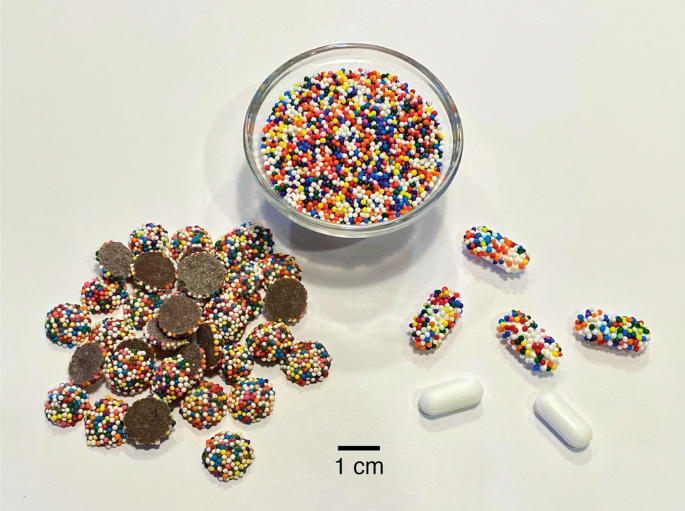カラフルなノンパレルで、薬のカプセルや偽造ファッションを一意に識別できる Colorful nonpareils can uniquely identify drug capsules and counterfeit fashions
2022-05-06 カリフォルニア大学リバーサイド校(UCR)
・この技術は、彼がCandyCodeと呼び、小さな多色キャンディーのノンパレルを医薬品のカプセルや錠剤の一意に識別できるコーティングとして使用するもので、Scientific Reportsに発表されています。
・製造直後の錠剤にノンパレイルをランダムに塗布すると、偶然に特定のパターンが繰り返されることはほとんどないため、そのパターン(CandyCode)を使って錠剤を一意に特定し、他の錠剤と区別することができる。
・製造者は、CandyCoded錠剤の写真を撮り、それぞれのノンパレルの位置と色を記録することにより、製造するすべての既知の真正錠剤のCandyCodeを含むデータベースを構築することができる。
・消費者は、携帯電話で錠剤を撮影し、画像をメーカーのサーバーに転送するだけで、その錠剤のCandyCodeがデータベース内の既知の良品CandyCodeと一致するか(その錠剤は本物)、データベースに一致しないかを判断することができる。
<関連情報>
- https://news.ucr.edu/articles/2022/05/06/candy-coated-pills-could-prevent-pharmaceutical-fraud
- https://www.nature.com/articles/s41598-022-11234-4
CandyCodes:医薬品の真正性を確認するためのシンプルで普遍的な食用識別子 CandyCodes: simple universally unique edible identifiers for confirming the authenticity of pharmaceuticals
William H. Grover
Scientific Reports Published: 06 May 2022
DOI:https://doi.org/10.1038/s41598-022-11234-4

Abstract
Counterfeit or substandard medicines adversely affect the health of millions of people and cost an estimated $200 billion USD annually. Their burden is greatest in developing countries, where the World Health Organization estimates that one in ten medical products are fake. In this work, I describe a simple addition to the existing drug manufacturing process that imparts an edible universally unique physical identifier to each pill, tablet, capsule, caplet, etc. This technique uses nonpareils (also called sprinkles and “hundreds and thousands”), tiny inexpensive multicolor candy spheres that are normally added to other candies or desserts as decorations. If nonpareils are applied at random to a pill immediately after manufacture, the specific pattern they form is unlikely to ever be repeated by random chance; this means that the pattern (or “CandyCode”) can be used to uniquely identify the pill and distinguish it from all other pills. By taking a photograph of each CandyCoded pill after manufacture and recording the location and color of each nonpareil, a manufacturer can construct a database containing the CandyCodes of all known-authentic pills they produce. A consumer can then simply use a cellphone to photograph a pill and transfer its image to the manufacturer’s server, which determines whether the pill’s CandyCode matches a known-good CandyCode in their database (meaning that the pill is authentic) or does not have a match in the database (in which case the consumer is warned that the pill may be counterfeit and should not be consumed). To demonstrate the feasibility of using random particles as universal identifiers, I performed a series of experiments using both real CandyCodes (on commercially produced chocolate candies) and simulated CandyCodes (generated by software). I also developed a simple method for converting a CandyCode photo to a set of strings for convenient storage and retrieval in a database. Even after subjecting CandyCodes to rough handling to simulate shipping conditions, the CandyCodes were still easily verifiable using a cellphone camera. A manufacturer could produce at least 1017<?XML:NAMESPACE PREFIX = “[default] http://www.w3.org/1998/Math/MathML” NS = “http://www.w3.org/1998/Math/MathML” />1017 CandyCoded pills—41 million for each person on Earth—and still be able to uniquely identify each CandyCode. By providing universally-unique IDs that are easy to manufacture but hard to counterfeit, require no alteration of the existing drug formulation and minimal alteration of the manufacturing process, and need only a cameraphone for verification, CandyCodes could play an important role in the fight against fraud in pharmaceuticals and many other products.


